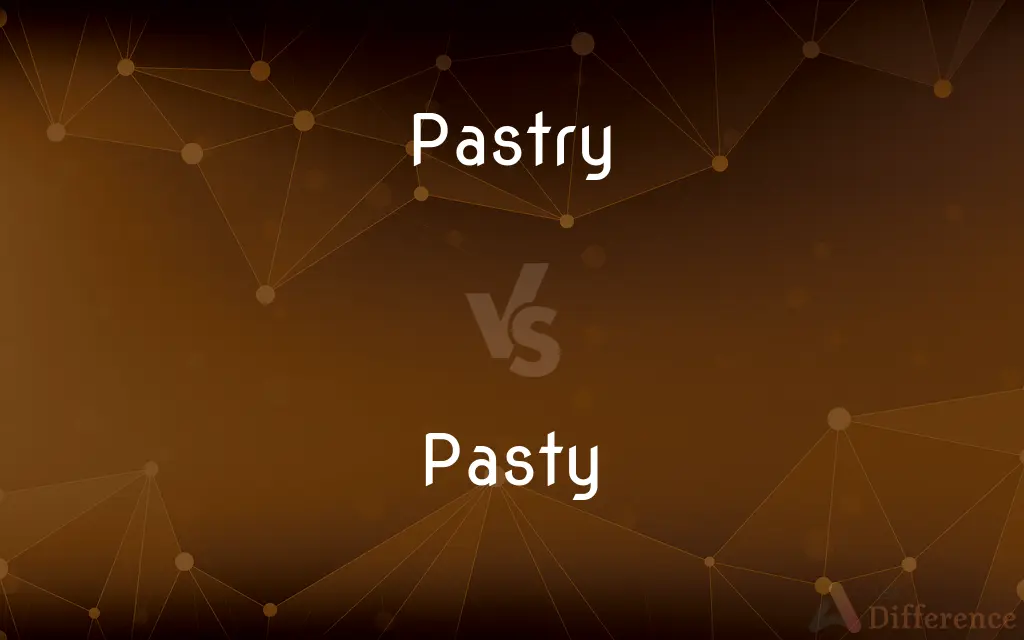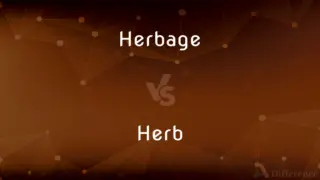Pastry vs. Pasty — What's the Difference?
By Tayyaba Rehman & Maham Liaqat — Updated on February 28, 2024
Pastry is a dough of flour, water, and fat used as a base or covering in baked goods, while a pasty is a baked pastry filled with meat and vegetables, originating from Cornwall.

Difference Between Pastry and Pasty
Table of Contents
ADVERTISEMENT
Key Differences
Pastry refers to a mixture used in baking that becomes the foundation or covering for various dishes, especially desserts. It is versatile and can be sweet or savory, depending on the ingredients added. Pasty, on the other hand, is a specific type of pastry that is crimped on one side, filled with a mixture of meat, potatoes, and vegetables, and is considered a traditional dish in Cornwall, UK. It's a complete meal in itself.
The texture of pastry dough varies widely, from flaky and light to dense and crumbly, influenced by the type and amount of fat used and the mixing technique. Pasties, however, aim for a sturdy, slightly crumbly crust that holds the filling during baking and eating, providing a portable meal option.
Pastry can be a base for many kinds of desserts like pies, tarts, and quiches, as well as for decorating purposes in culinary arts. Pasties serve as a hearty main dish, often associated with miners' lunches in historical contexts, indicating its role as a convenient and filling meal.
The cultural significance of pastry spans globally, reflecting in various forms like the French croissant or the Italian cannoli. The pasty holds a particular place in Cornish culture, symbolizing regional identity and pride, with the Cornish pasty even gaining protected status to preserve its heritage.
Pastry is a broad category encompassing various baked goods, the pasty is a specific item with a distinct shape, filling, and historical background, showcasing the diversity within the world of baked goods.
ADVERTISEMENT
Comparison Chart
Definition
Dough of flour, water, and fat used in baking.
Baked pastry filled with meat and vegetables.
Origin
Global
Cornwall, UK
Texture
Varies from flaky to crumbly
Generally sturdy and slightly crumbly
Use
Base or covering for desserts and savory dishes
Complete meal, traditionally portable
Cultural Significance
Widespread, varies by region
Strongly associated with Cornish identity
Compare with Definitions
Pastry
Versatile in culinary arts for decoration.
He used pastry dough to create intricate designs on the cake.
Pasty
A baked pastry filled with meat and vegetables.
The miner took a pasty for his lunch.
Pastry
A dough made for baking into various shapes and sizes.
The baker rolled the pastry to make croissants.
Pasty
Designed to be a portable meal.
The pasty was wrapped tightly to be eaten on the go.
Pastry
Can be sweetened for desserts.
The sweet pastry was filled with custard and fruit.
Pasty
Symbol of Cornish identity and pride.
The festival celebrated Cornish culture with music and pasties.
Pastry
Used as a base for pies and tarts.
She prepared a buttery pastry for the apple pie.
Pasty
Contains a mixture of beef, potatoes, and turnips.
Each pasty was filled with a hearty mix of beef and vegetables.
Pastry
Integral in making quiches and other savory dishes.
The quiche had a perfectly flaky pastry crust.
Pasty
Originates from Cornwall, known for its crimped edge.
We bought a traditional Cornish pasty on our trip.
Pastry
One of these baked foods.
Pasty
A pasty () is a British baked pastry, a traditional variety of which is particularly associated with Cornwall, United Kingdom. It is made by placing an uncooked filling, typically meat and vegetables, on one half of a flat shortcrust pastry circle, folding the pastry in half to wrap the filling in a semicircle and crimping the curved edge to form a seal before baking.
Pastry
Articles of food made of paste, or having a crust made of paste, as pies, tarts, etc.
Pasty
A pie consisting usually of meat wholly surrounded with a crust made of a sheet of paste, and often baked without a dish; a meat pie.
A large pasty baked in a pewter platter.
Pastry
Pastry is a dough of flour, water and shortening (solid fats, including butter or lard) that may be savoury or sweetened. Sweetened pastries are often described as bakers' confectionery.
Pastry
Dough or paste consisting primarily of shortening or another fatty substance mixed with flour and water, often baked and used as a crust for sweet foods such as pies and tarts.
Pastry
Baked sweet foods made with pastry
Viennese pastry.
Pastry
(Informal) A sweet baked good.
Pastry
A dough of flour and water and shortening
Pastry
Any of various baked foods made of dough or batter
Common Curiosities
What makes a Cornish pasty authentic?
An authentic Cornish pasty has a specific mixture of beef, potatoes, turnips (swedes), and is crimped on one side.
What is the main difference between pastry and pasty?
Pastry is a dough used in baking, while a pasty is a specific type of filled pastry.
Can any pastry be used to make a pasty?
Typically, a sturdy, slightly crumbly pastry is used for pasties to hold the filling.
Can pasties be eaten cold?
Yes, pasties can be eaten cold, but they are often enjoyed hot or warm.
Do pasties have a protected status?
Yes, the Cornish pasty has protected status to preserve its traditional recipe and method.
Is pastry only used for desserts?
No, pastry can be used for both sweet desserts and savory dishes.
Are all pastries flaky?
Not all pastries are flaky; the texture varies widely depending on the recipe and technique.
What are some common fillings for pasties besides meat and vegetables?
Some variations include cheese, seafood, or even sweet fillings, though these are less traditional.
Are pasties sweet or savory?
Pasties are traditionally savory, filled with meat and vegetables.
Can pastries be healthy?
While pastries can be high in fats and sugars, variations with whole grains and less sugar can be healthier.
How do you store pasties?
Pasties can be stored in the refrigerator and reheated, or frozen for longer storage.
Why is the crust of a pasty crimped?
The crimped edge serves as a handle, making it easier to eat by hand, especially historically for miners.
What is the cultural significance of pastries?
Pastries have diverse cultural significances globally, reflecting regional tastes and traditions.
Is making pastry difficult?
Making pastry can be challenging for beginners, but practice improves technique and results.
Can vegan versions of pasties be made?
Yes, vegan pasties can be made using plant-based fillings and fat in the pastry.
Share Your Discovery

Previous Comparison
Herbage vs. Herb
Next Comparison
Proactive vs. RetroactiveAuthor Spotlight
Written by
Tayyaba RehmanTayyaba Rehman is a distinguished writer, currently serving as a primary contributor to askdifference.com. As a researcher in semantics and etymology, Tayyaba's passion for the complexity of languages and their distinctions has found a perfect home on the platform. Tayyaba delves into the intricacies of language, distinguishing between commonly confused words and phrases, thereby providing clarity for readers worldwide.
Co-written by
Maham Liaqat













































